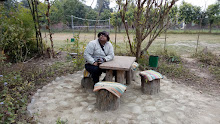Anethum Sowa Roxb.
DILL !!
COMMON NAME: English Name:Dill, Sowa, soya, ans more.BOTANICAL NAME :Anethum Sowa Roxb
FAMILY :Apiaceae / Umbellifarae
PART USED: Seeds, Leaves
GENERAL DESCRIPTION: It has been used in ayurvedic medicines since ancient times and it is a popular herb widely used as a spice and also yields essential oil. It is an aromatic and annual herb of apiaceae family. The Ayurvedic uses of dill seeds are carminative, stomachic and diuretic. There are various volatile components of dill seeds and herb; carvone being the predominant odorant of dill seed and α-phellandrene, limonene, dill ether, myristicin are the most important odorants of dill herb. Other compounds isolated from seeds are coumarins, flavonoids, phenolic acids and steroids. The main purpose of this review is to understand the significance of Anethum graveolens in ayurvedic medicines and non-medicinal purposes and emphasis can also be given to the enhancement of secondary metabolites of this medicinal plant.
BOTANICALLY :
**Dill grows to 40–60 cm (16–24 in), with slender stems and alternate, finely divided, softly delicate leaves 10–20 cm (3.9–7.9 in) long.
**The ultimate leaf divisions are 1–2 mm (0.039–0.079 in) broad, slightly broader than the similar leaves of fennel, which are threadlike, less than 1 mm (0.039 in) broad, but harder in texture.
**The flowers are white to yellow, in small umbels 2–9 cm (0.79–3.5 in) diameter.
**The seeds are 4–5 mm (0.16–0.20 in) long and 1 mm (0.039 in) thick, and straight to slightly curved with a longitudinally ridged surface.
USES:
~~People Use This For:
Orally, dill is used for gastrointestinal disorders, loss of appetite, kidney disease, flatulence, fever and colds, cough, bronchitis, infectious disease, liver and gallbladder complaints, urinary tract disorders, hemorrhoids, spasms, neuropathy, renal colic, dysuria, genital ulcers, dysmenorrhea, and insomnia and other sleep disorders. Topically, dill seed is used for mouth and throat inflammation.
In foods, dill is used as a culinary spice.
In manufacturing, dill oil is used as a fragrance component in cosmetics, soaps, and perfumes.
ETHNOBOTANIC DATA:It is used to treat uterus fibroid in combination with calamus, crystal sugar, neem leaves, and onion bulb. Suppositories are made in butter.
It is also used for infertility with calamus.
When given orally in food increases lactation and reduces pain during menstruation.
It is also reported by ladies to be used for menstrual problem like menorrhea, amenorrhea, leucorrhea
It is used for expulsion of plasma membrane after child birth.
For menorrhea it is given orally with betel nuts.
Water of dill is given in fasting for amenorrhea.
In combination with herbs it lowers abdominal size after child birth.
It regulates menstrual cycle at their 1st menstrual cycle.
Scientific Data:
It increases lactation and prevent early pregnancy after birth.
It is used as emmenagogue, galactagogue also used in amenorrhea and dysmenorrhea.
It is antimicrobial19 and anti fungal.
SOURCES :>>http://www.iccs.edu/fmed/
>>http://
>>http://
>>http://en.wikipedia.org/
,+leaf+sheaths+are+larger,+flowers+are+lighter+yellow,+larger+and+lesser+number+of+rays.+In+Anothum+stems+are+grass.JPG)
%5D+ban+tulsi.JPG)










0 comments:
Post a Comment